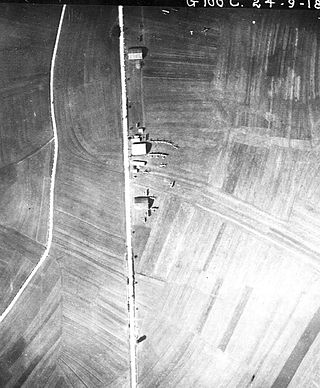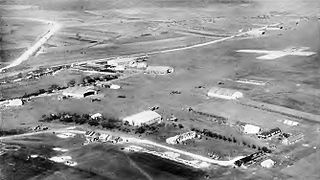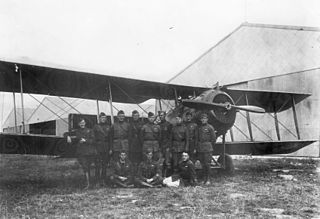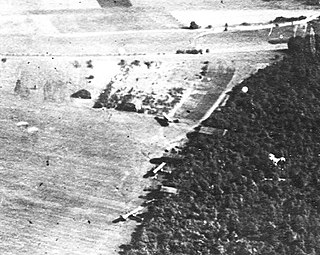
The 103rd Aero Squadron was an aviation pursuit squadron of the U.S. Air Service that served in combat in France during World War I. Its original complement included pilots from the disbanded Lafayette Escadrille and Lafayette Flying Corps. One of those pilots, Paul F. Baer, became the first ace of an American unit in World War I.

The 28th Aero Squadron was a United States Army Air Service unit that fought on the Western Front during World War I.

The III Corps Observation Group was a United States Army Air Service unit that fought on the Western Front during World War I as part of the Air Service, First United States Army. It was demobilized on 12 May 1919. There is no modern United States Air Force unit that shares its lineage and history.

The Organization of the Air Service of the American Expeditionary Force on November 11, 1918, represents its maximum strength in World War I. Units of the Air Service are listed as assigned to the order of battle for that date, which was that of the Armistice with Germany. The first air unit arrived in France in September 1917, while the final air unit reaching the front did so on November 9, 1918. Unit operations began in April 1918. At the armistice, 57,508 officers and men served in the Air Service of the AEF, 24,512 in the Zone of Advance, and 32,996 in the Services of Supply. Of its 6,861 officers, 4,088 were on flying status and 219 were qualified observation balloon aviators. 1,724 of those on flying status and approximately 100 of the balloonists served in combat units.

Vaucouleurs Aerodrome, was a temporary World War I airfield in France. It was located 2.1 miles (3.4 km) West-Northwest of Vaucouleurs, in the Meuse department of France, located approximately 300 km (190 mi) from Paris.

Foucaucourt Aerodrome was a temporary World War I airfield in France. It was located 4.3 miles (6.9 km) ESE of Foucaucourt-sur-Thabas, in the Meuse department in Lorraine in north-eastern France.

Saints Aerodrome, was a temporary World War I airfield in France. It was located 0.7 miles (1.1 km) North of Saints, in the Île-de-France region in north-central France.

Rembercourt Aerodrome was a temporary World War I airfield in France. It was located 1.6 miles (2.6 km) east-northeast of Rembercourt aux Pots, now part of Rembercourt-Sommaisne, in the Meuse department in northeastern France.

Amanty Airdrome was a temporary World War I airfield in France. It was located 1 mile (1.6 km) northwest of Amanty, in the Meuse department in the Lorraine region in northeastern France (48.527383,5.598371).

Vavincourt Aerodrome, was a temporary World War I airfield in France. It was located 0.5 miles (0.80 km) south of Vavincourt, in the Meuse department in north-eastern France.

Maulan Aerodrome, was a temporary World War I airfield in France. It was located 0.2 miles (0.32 km) South-Southwest of the commune of Maulan, in the Meuse department in Lorraine in north-eastern France.
Belrain Aerodrome was a temporary World War I airfield in France. It was located 0.7 miles (1.1 km) South of Belrain, in the Meuse department in the Lorraine region in northeastern France.

Souilly Aerodrome was a temporary World War I airfield in France. It was located 1 mile (1.6 km) Northeast of Souilly, in the Meuse department in north-eastern France.

Remicourt Aerodrome was a temporary World War I airfield in France. It was located 1.2 miles (1.9 km) West of Remicourt, in the Marne department in north-eastern France.

Parois Airdrome, was a temporary World War I airfield in France. It was located near the commune of Aubréville, in the Lorraine region in northeastern France.

The 3rd Pursuit Group was a United States Army Air Service unit that fought on the Western Front during World War I as part of the First United States Army. Formed in France in July 1918, the group was assigned to the 1st Pursuit Wing and saw action in the final months of the war, supporting the Battle of Saint-Mihiel and the Meuse-Argonne Offensive. Following the end of the war, the group was demobilized in France in late December 1918. There is no modern United States Air Force unit that shares its lineage and history.
Pretz-en-Argonne Aerodrome, was a temporary World War I airfield in France. It was located near the commune of Pretz-en-Argonne, in the Meuse department in Lorraine in northeastern France.

The 213th Aero Squadron was a United States Army Air Service unit that fought on the Western Front during World War I.

Autreville Airdrome was a temporary World War I airfield in France. It was located 9 miles (14 km) S of Toul, at the northern tip of the Vosges department in northeastern France, near the large depot of Colombey les Belles.

The First Army Air Service was an Air Service, United States Army unit that fought on the Western Front during World War I as part of the Air Service, First United States Army. The First Army Air Service was the largest and most diverse Air Service combat organization of the American Expeditionary Forces in France, and most American Air Service combat units were assigned to it when assigned to the front.


















